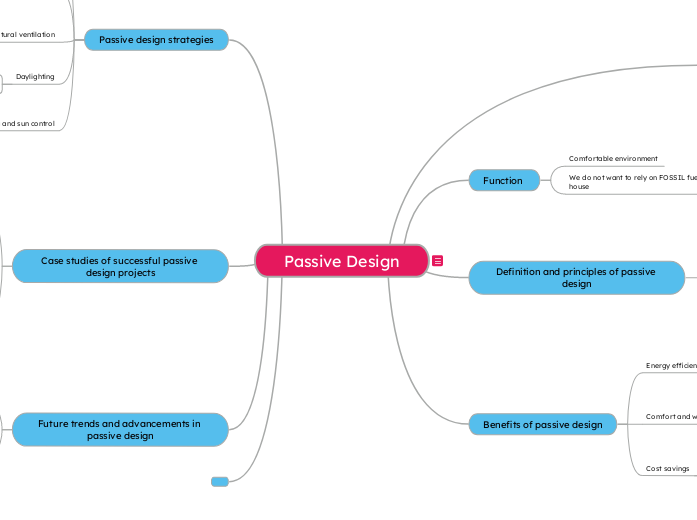Passive Design
Definition of passive design
Energy efficient house
A passive house will keep warm for a long period of time without having to consistently put on the heating.
Concept ? The idea of a passive house is to ? Maximise heat gain and minimise heat loss
Subtopic
Function
Comfortable environment
We do not want to rely on FOSSIL fuels to heat the house
Active Heating = Oil boilers or heating systems that are not renewable.
Definition and principles of passive design
Key Principles of passive design
Compact form
Airtightness
MVHR
Super Insulation
Solar Gain/Heat Gain
Preventing Thermal Bridging
Thermal Mass
Benefits of passive design
Energy efficiency
Reduction in heating and cooling loads
Lower energy consumption
Comfort and well-being
Improved thermal comfort
Enhanced natural lighting
Better indoor air quality
Cost savings
Decreased energy bills
Potential for government incentives and rebates
Passive design strategies
Orientation and layout
Taking advantage of solar angles
Minimizing exposure to prevailing winds
Insulation and thermal mass
Proper insulation materials and installation
Utilizing thermal mass for heat storage
Natural ventilation
Cross-ventilation through strategic window placement
Utilizing stack effect for airflow
Daylighting
Incorporating skylights and light shelves
Using reflective surfaces to maximize natural light
Shading and sun control
Designing overhangs and awnings
Implementing shading devices such as blinds or curtains
Case studies of successful passive design projects
Residential buildings
Example 1: Passive solar house in a cold climate
Use of south-facing windows for solar heat gain
Insulated foundation and walls
Example 2: Passive cooling strategies in a hot climate
Ventilation through building orientation and natural airflow
Use of shading devices to reduce solar heat gain
Commercial buildings
Example 1: Passive design in an office building
Daylighting strategies to reduce artificial lighting use
Insulation and thermal mass for temperature control
Example 2: Passive design in a shopping center
Efficient HVAC systems and natural ventilation
Integration of daylighting and shading techniques
Future trends and advancements in passive design
Technological innovations
Smart building systems for optimized passive design
Integration of renewable energy sources
Policy and regulations
Increasing emphasis on energy-efficient construction codes
Incentives for passive design implementation
